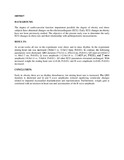| dc.description.abstract | BACKGROUND:
The degree of cardiovascular function impairment parallels the degree of obesity and obese subjects have abnormal changes on the electrocardiogram (ECG). Early ECG changes in obesity have not been previously studied. The objective of the present study was to determine the early ECG changes in obese rats and their relationship with anthropometric measurements.
RESULTS:
At seven weeks all rats in the experiment were obese and in sinus rhythm. In the experiment resting heart rate was increased (364±13 vs. 313±12 bpm, P<0.01). In contrast, the following parameters were shortened: QRS duration (77±3.6 vs. 65±2.6 ms, P<0.01); QT interval (102±5.2 vs. 88±3.7 ms, P<0.05); Q wave amplitude (-12.8±1.0 vs. -5.1±0.9 μv, P<0.01); and T wave amplitude (18.8±1.4 vs. 5.8±0.6, P<0.01). All other ECG parameters remained unchanged. With increased weight the resting heart rate (r=0.46, P<0.01) and R wave amplitude (r=0.60, P<0.01) increased.
CONCLUSION:
Early in obesity there are no rhythm disturbances, but resting heart rate is increased. The QRS duration is shortened and Q and T-wave amplitudes reduced signifying ventricular changes related to impaired myocardial depolarization and repolarization. Furthermore, weight gain is correlated with an increase in heart rate and accentuation of the R wave amplitude. | en_US |

